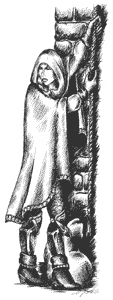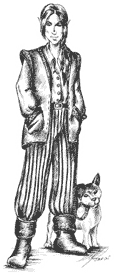Halflings
 Halflings, like the elves and gnomes, were created by Shylar. But rather than to tend her gardens, the halflings were gifts to Pittok, to fill his halls with joy and laughter and to act as a reminder to him always of the joy that he had brought to her. Like the elves and gnomes, the halflings were sent to Arrasia to aid in the War of Chaos, but were soon overwhelmed, their numbers divided and forced into hiding. Many halfling enclaves appeared, hidden amongst the hills on the edges of the human nations, where they lived in peace. However, halflings are curious and hardworking creatures and instilled with a natural wanderlust, so they soon began crisscrossing the plains of Arrasia and now can be found in most places. Indeed, such has been their success in finding new homes and in being accepted by all manner of races, that they are now the second most numerous race, behind humans.
Halflings, like the elves and gnomes, were created by Shylar. But rather than to tend her gardens, the halflings were gifts to Pittok, to fill his halls with joy and laughter and to act as a reminder to him always of the joy that he had brought to her. Like the elves and gnomes, the halflings were sent to Arrasia to aid in the War of Chaos, but were soon overwhelmed, their numbers divided and forced into hiding. Many halfling enclaves appeared, hidden amongst the hills on the edges of the human nations, where they lived in peace. However, halflings are curious and hardworking creatures and instilled with a natural wanderlust, so they soon began crisscrossing the plains of Arrasia and now can be found in most places. Indeed, such has been their success in finding new homes and in being accepted by all manner of races, that they are now the second most numerous race, behind humans.
Halflings stand about 3 feet tall and usually weigh around 30 pounds. They have brown or black eyes and hair color ranges from blonde through to jet black. Halflings like to have long hair, which is often kept tied back or with a pony tail. Women's hair is often exceptionally long. Halfling choose their clothes based on comfort and practacality, but enjoy wearing small trinkets, especially earings and noserings. Halflings live relatively short lives, with the average life span being little over 30 years. They have their own language, though those that do not live in a halfling enclave will almost certainly speak the primary language used where they live.
Halfling Homelands
Halflings are numerous throughout Arrasia; their wit and amicable nature making them very few enemies and endearing them to most. Within human communities, halflings are common enough, where they work hard and play hard, often being found at the center of attention in the local tavern. Unlike other races, who tend to be drawn together when living amongst humans, halflings are happy to scatter themselves and live where they can find the comfort they so enjoy. In some large cities, however, small halfling enclaves can be found - but they are welcoming and jovial places.
However, despite the halflings' demographic spread, there can be found, on the very edges of the civilized nations, the small nations of halflings which were formed during the War of Chaos, when the halflings arrived in Arrasia unprepared and ill-equipped for the violence of the world as it was. Many have since been crushed and become a part of history, and now but a few survive.
The most northern of these, and by far and away the largest, is Ciradel, surrounded by The Great Northern Hills where they now find themselves as a neighbor to the people of The Northern Territories, as well as the gnomes and dwarves that have dwelt there for even longer than themselves. Living in small rural communities spread out throughout the region, the largest of these is Haighfain (though small relative to the towns and cities of men).
Further east, enclosed to the west by the Fayn Eduth and to the east by The Golden Peaks, is Bayfork, where the land is green and fertile. Here, the halfling communities can be found in the very mountains, where they mine gold and silver. The largest of these communities is Baridge, nestled up against the base of the mountains. The halflings here make a good living trading with the elves to sell to the dwarves and vice-versa.
The third of the halfling nations is Nendor, which sits isolated amongst the Gava Hills, where they trade with the gnomes and dwarves. It is also the most exposed, with raids from Uradun and the tribes of Yarasal J'naria a common problem. Balthor is the largest of the halfling communities in Nendor.
Halfling Politics and Society
Outside of the halfling nations, halflings generally follow whatever rules are in place for that community or nation. They are not sticklers for the rules, but instead abide by those that suit themselves and, when necessary, circumnavigate those that don't, which can on occasions lead them into some trouble.
 The settlements of the halfling nations - usually made up of compact stone structures with large fireplaces - are semi-autonomous, each with their own elected council, which votes for the town mayor, who makes all final decisions. This means that some communities are more (or less) autocratic than others, depending on how the mayor wields the power invested in them. However, all of the communities rally under a single banner, with one of the mayors elected as the President of their nation. These elections are open only to the other mayors, who are not allowed to vote for themselves. The President wields almost absolute power, but can be ousted by those that voted him in with a second vote.
The settlements of the halfling nations - usually made up of compact stone structures with large fireplaces - are semi-autonomous, each with their own elected council, which votes for the town mayor, who makes all final decisions. This means that some communities are more (or less) autocratic than others, depending on how the mayor wields the power invested in them. However, all of the communities rally under a single banner, with one of the mayors elected as the President of their nation. These elections are open only to the other mayors, who are not allowed to vote for themselves. The President wields almost absolute power, but can be ousted by those that voted him in with a second vote.
Each settlement is responsible for maintaining a small militia, which can be called upon in times of trouble, either locally, by the mayor, or nationally, by the President. Halfling armies can be mobilized rapidly to defend their lands and make up for their lack of strength through mobility, speed and working to their strengths. Halflings prefer to fight defensively, usually hiding and launching ranged attacks as their foe approaches - especially with their slingers, for which they are renown. Their tactics are very much like those of elves, concealing themselves before striking rapidly and retreating back into their hiding places. In open combat, halfling armies can be quickly decimated and routed.
Halflings themselves are generally happy-go-lucky individuals who will turn their hands to almost anything manual. Good miners, farmers and craftsmen, halfling communities are a hive of activity. And when the sun sets and the work for that day is finished, so their social nature takes over and the taverns are filled with merriment and high spirits as they settle in for a long and relaxing evening, with flagons of their favorite beverage, cider.

